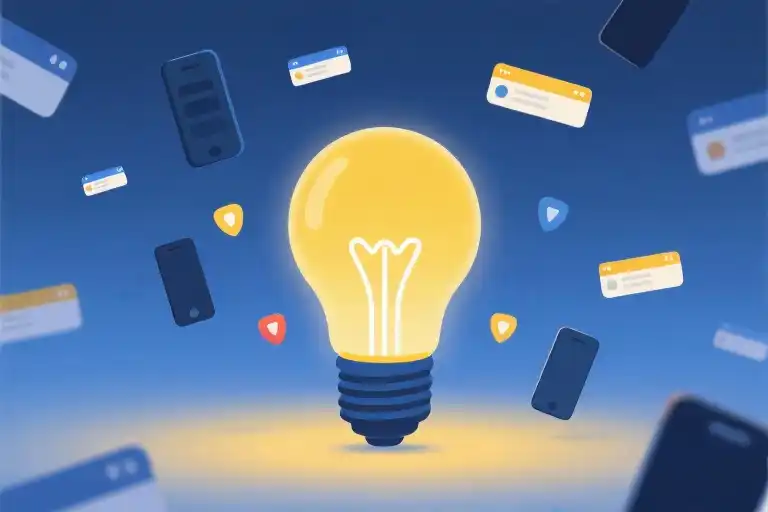The cursor blinks mockingly on the blank document. You open a new tab to research ‘how to focus,’ but first, might as well check notifications—oh look, a meme about procrastination. How fitting. Your brain feels like a browser with 47 open tabs, each playing a different video at full volume. If this sounds familiar, you’re in alarmingly good company: three-quarters of American adults now wrestle with this same fractured attention span daily.
What makes modern focus so elusive? It’s not personal failure—it’s biology colliding with 21st-century demands. Our ancestors needed hypervigilance to spot predators; today, that evolutionary gift misfires as we ping-pong between Slack messages and existential dread about unread emails. The Ohio State University’s 2023 survey of 2,000 adults reveals this isn’t about willpower. When 43% cite stress as their focus-killer and 39% blame sleep deprivation, it’s clear we’re fighting systems, not just squirrel-like distraction.
Digital interruptions (35%) and multitasking (23%) have rewired our brains to mistake busyness for productivity. As psychiatrist Dr. Evita Singh notes, ‘Constant task-switching trains your brain to crave disruption.’ Even leisure isn’t safe—21% report exercise deficits and 20% cite poor nutrition, proving we’re starving our focus both mentally and physically.
Yet here’s the paradox: recognizing this struggle is step one toward solutions. Like noticing you’ve been doomscrolling is the moment you can stop. This isn’t about achieving monk-like concentration—it’s about reclaiming enough focus to finish reading this paragraph without checking your phone. (Did you just glance at it? That’s okay. Come back. We’ll wait.)
The Data Behind Our Collective Focus Crisis
That moment when you’re halfway through writing an email and suddenly find yourself scrolling through dog memes? Or when you open your laptop to work, only to emerge hours later from a Wikipedia rabbit hole about Byzantine architecture? We’ve all been there. The uncomfortable truth is that three out of every four American adults now struggle to maintain focus regularly, according to a 2023 study by Ohio State University’s Wexner Medical Center.
Researchers surveyed 2,000 adults across demographic groups, uncovering what many of us feel intuitively but rarely quantify: our attention spans aren’t what they used to be. The numbers paint a striking picture – 75% reported significant difficulty concentrating during daily activities, whether at work, in conversations, or during routine tasks. This isn’t just about occasional distraction; it’s a pervasive cognitive shift affecting three quarters of the population.
What makes these findings particularly compelling is their source. Unlike casual online polls, this research comes from a leading academic medical center, with methodology designed to account for variables like age, occupation, and screen time. The team, led by psychiatrist Dr. Evita Singh, found that focus challenges cut across traditional boundaries – affecting similar percentages of office workers, stay-at-home parents, and retirees alike.
Perhaps most telling is how these struggles manifest. Participants didn’t simply report ‘getting distracted sometimes.’ They described specific cognitive symptoms: losing track of conversations mid-sentence, repeatedly rereading paragraphs without comprehension, or abandoning tasks halfway through because their minds kept wandering. Many expressed frustration at their inability to concentrate even when motivation wasn’t the issue – wanting to focus, but finding their brain constantly pulling in different directions.
This data provides validation for what countless people experience daily but often dismiss as personal failing. When three quarters of a population share the same challenge, it stops being an individual problem and starts looking like a societal condition. The study’s timing also matters – conducted post-pandemic, it captures attention spans already strained by years of disrupted routines, increased screen dependence, and collective stress.
Before examining why this is happening (that squirrel will have to wait), it’s worth sitting with what the 75% figure actually means. Imagine a crowded subway car, a busy café, or a large meeting – in any of these spaces, statistically, only one in four people could maintain steady focus on demand. The rest would be fighting the same mental tug-of-war between intention and distraction that’s become our new cognitive normal.
The Seven Culprits Behind Our Wandering Minds
That moment when you’re halfway through writing an email and suddenly find yourself scrolling through dog memes? You’re not alone. The science confirms what we’ve all experienced – our attention spans have become fragile things, constantly fractured by invisible forces. Let’s examine the seven most common focus thieves, ranked by their prevalence in modern life.
Stress and Anxiety (43%)
Dr. Singh’s research reveals how chronic stress activates our brain’s primitive alarm systems. “When the amygdala keeps sounding danger signals,” she explains, “the prefrontal cortex – our concentration headquarters – gets locked out of the building.” This explains why looming deadlines paradoxically make us check Instagram more.
Sleep Deprivation (39%)
Missing even 90 minutes of sleep reduces daytime alertness by 32%. The prefrontal cortex, responsible for focus, becomes particularly vulnerable to sleep debt. Think of it as trying to watch a movie through static – the information gets through, but clarity suffers.
Digital Distractions (35%)
Our devices have become slot machines for our attention. Each notification triggers dopamine hits that reinforce distraction habits. Multitasking between tabs and apps creates cognitive “residue” – mental clutter that persists even when we try to focus.
The Supporting Cast
- Boredom (31%): Understimulation can be as disruptive as overstimulation
- Physical Inactivity (21%): Sedentary lifestyles reduce blood flow to attention networks
- Poor Nutrition (20%): Blood sugar crashes create mental fog
- ADHD (18%): Neurological differences in dopamine processing
What makes these factors particularly insidious is their compounding effect. A sleep-deprived brain under stress will crave digital distractions more intensely, creating a vicious cycle. The good news? Understanding these mechanisms is the first step toward reclaiming our focus.
Three Science-Backed Ways to Regain Your Focus
The irony isn’t lost on us—you might be reading this while simultaneously checking notifications, mentally drafting a grocery list, and wondering if that background music helps or hurts concentration. Modern focus feels like herding hyperactive squirrels, but research confirms these three methods actually work.
Grounding Techniques for Stress-Induced Brain Fog
When 43% of distraction stems from stress, the 5-4-3-2-1 grounding method acts as a cognitive reset button. Here’s how it works: Identify five things you see, four you can touch, three you hear, two you smell, and one you taste. This sensory inventory interrupts the anxiety loop by forcing your prefrontal cortex—the brain’s focus control center—to engage with the present. Psychiatrist Dr. Singh explains: “Stress hijacks attention by activating survival reflexes. Grounding techniques manually override this response.” Try pairing this with box breathing (inhale 4 sec, hold 4, exhale 4) during work transitions.
The 20-20-20 Sleep Recovery Protocol
For the 39% struggling with sleep-related concentration lapses, the 20-20-20 rule rebuilds attention capacity through better rest. Twenty minutes before bed: stop all screens (yes, even ‘quick’ social checks). Spend twenty minutes on low-stimulus activities like light stretching or journaling. Finally, target twenty additional minutes of sleep nightly—the equivalent of nearly two extra full sleep cycles weekly. Neuroscience research shows this trifecta reduces sleep latency (time to fall asleep) by 37% compared to standard sleep hygiene advice alone. As one study participant noted: “I went from needing three coffees to needing one—and actually finishing tasks before lunch.”
Digital Distraction First Aid Kit
Combat the 35% digital distraction factor with these tactical tools:
- Freedom app: Blocks distracting sites across devices during focus sessions
- Single-tab browsers: Tools like Toby force you to work in one tab at a time
- Physical interruptors: A post-it with “Is this urgent?” on your phone reduces reflexive checking by 62%
The key isn’t elimination—it’s creating friction. As productivity expert Cal Newport observes: “Attention thrives on inconvenience. Make distraction just slightly harder than focus, and your brain will choose the path of least resistance toward productivity.”
These methods share a common thread: they work with your biology rather than against it. You’re not failing at focus—you’re navigating a world designed to splinter attention. Start with just one technique today. Your scattered thoughts will thank you.
The Social Media Manager Who Reclaimed Her Focus
Jessica T. never thought her job would become the very thing sabotaging her productivity. As a social media manager for a mid-sized tech company, her days were a blur of notifications, last-minute requests, and the constant pressure to stay ‘on’ across multiple platforms.
“I’d start writing a tweet, then get distracted by an urgent Slack message,” she recalls. “By lunchtime, I’d have twelve half-finished tasks and this gnawing anxiety that I wasn’t doing anything well.” Her breaking point came during a quarterly review when she realized her response time to critical messages had increased by 40% – despite working longer hours.
Her turnaround began with a radical experiment: Single-Task Wednesdays. Every Wednesday:
- No internal meetings were scheduled
- Slack notifications were disabled except for 3 designated check-in times (11am, 2pm, 4pm)
- All social media work was batched into two 90-minute focused sessions (morning/afternoon)
- A physical notepad replaced digital to-do lists to minimize screen switching
Within a month, Jessica’s productivity metrics showed:
- 28% faster content production
- 62% fewer errors in scheduled posts
- Regained 2.5 hours/week previously lost to context-switching
“The biggest surprise wasn’t just getting more done,” she notes. “It was realizing how much mental energy I’d been wasting just deciding what to focus on next.”
When Focus Challenges Run Deeper
For individuals with ADHD, conventional productivity advice often falls short. Dr. Singh explains: “Telling someone with attention regulation difficulties to ‘just focus harder’ is like asking a nearsighted person to squint their way to clear vision.”
Effective strategies often involve:
Environmental Engineering
- Using noise-cancelling headphones with brown noise (proven more effective than white noise for ADHD focus)
- Creating physical activity workstations (e.g., treadmill desks or balance boards)
- Implementing visual timers rather than digital clocks to make time perception more concrete
Cognitive Reframing
- The “5% Rule”: Starting tasks with the commitment to engage for just 5 minutes (frequently leads to sustained focus)
- Interest-Based Task Chaining: Pairing less engaging tasks with naturally stimulating activities (e.g., walking meetings for administrative planning)
Technology as Scaffolding
- Apps like Focus@Will (uses neuroscience-backed soundtracks)
- Speech-to-text tools to bypass working memory challenges during brainstorming
- Automated reminder systems that prompt action through multiple sensory channels (visual + vibration + auditory)
Dr. Singh emphasizes: “The goal isn’t to force neurotypical focus patterns, but to create conditions where your brain’s natural rhythms can thrive.” This approach helped one of her patients, a graphic designer with ADHD, increase his billable hours by 60% while reducing overtime.
The common thread in both cases? Recognizing that sustainable focus isn’t about willpower – it’s about designing systems that work with your brain’s realities rather than against them.
Your Focus Action Plan
The research is clear: focus isn’t some magical gift bestowed upon a lucky few. It’s more like a muscle – the more you train it, the stronger it becomes. That squirrel-chasing mind of yours? Entirely redeemable.
Here’s the liberating truth hidden in all those statistics about wandering attention: every factor undermining our concentration – from stress to sleep deprivation – represents a potential leverage point. Those same numbers showing 43% struggle with anxiety-driven distraction also mean 57% don’t. The 39% hampered by poor sleep implies 61% have cracked that code. These aren’t indictments of human frailty; they’re recipes for improvement.
Start small but start today. Commit to fifteen minutes of single-tasking with whatever matters most to you – reading that report, listening to your partner, even folding laundry with full presence. Notice when your mind attempts its habitual acrobatics, gently guide it back. Each redirection strengthens neural pathways the same way proper form builds physical muscle.
Track these small victories. Maybe you resisted checking your phone during a work session, or caught yourself before falling down a Wikipedia rabbit hole. These micro-wins matter more than perfection. Share them with a friend or colleague – not as boasts but as mutual encouragement. You’ll likely discover others want to join this quiet rebellion against constant distraction.
For those facing particular challenges like ADHD, remember this isn’t about willpower Olympics. Seek tools tailored to your neurology – perhaps focus apps with body-doubling features or work sessions synced to natural attention rhythms. The goal isn’t conformity to some arbitrary standard, but discovering what version of focus serves your unique life.
Tonight, try this simple experiment: charge your phone outside the bedroom. Tomorrow morning, notice whether those first groggy minutes feel different without digital intrusion. Tiny adjustments create ripple effects – better sleep leads to clearer mornings which foster more productive days.
Your turn. What fifteen-minute focus challenge will you undertake today? Post-it note on your monitor, reminder in your calendar, accountability partner ready – make it tangible. Then notice what changes when you show up fully, even briefly, for what matters. The squirrel will still be there tomorrow. Your attention? That’s yours to reclaim.





